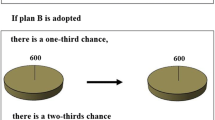Abstract
Many people espouse superstition, whether individually (e.g., wearing a lucky charm) or collectively (e.g., applying feng shui to the workplace) as a mechanism for garnering preferred life outcomes. Psychologists acknowledge the value of studying superstition at the personal level; yet our understanding of how superstitious beliefs influence risk-seeking tendencies is incomplete (e.g., Kramer and Block 2008). Drawing from prior research on superstition, astrometry, suspension of disbelief, and risk-seeking, this study applies the experiential consumption theory and ‘magical thinking’ literatures to test a model of risk-seeking tendencies. Because superstition is a joy-filled experiential consumptive practice for many consumers, it influences their behaviors meaningfully (Holbrook et al. 1986).
Superstitious beliefs (SUPER), self-assessed zodiac sign expertise (ZodEXP), intention to read horoscopes (IntHORO), attitude toward zodiac signs (AZOD), and suspension of disbelief for fictional works (SodFIC) and virtual reality (SodVR) are modeled as determinants of risk-seeking tendencies (RiskSEEK). Students enrolled in marketing courses at a southwestern US university completed the questionnaire during regularly scheduled classes. The mean age of respondents (N = 218) is 22.32 (SD = 2.53), with gender split evenly. Whites (71 %), Hispanics (18 %), and Blacks (8 %) are most represented, with seniors (59 %) and juniors (27 %) dominating the sample.
Estimation of the measurement model (30 items, 7 scales) confirms convergent and discriminant validity. The relationships were tested using SEM (LISREL). A COV matrix and MLE were used to estimate model parameters. Model estimation produced the following GOF statistics: χ 2(393df) = 1207.11 (P = 0.00), (CFI) = 0.94, (GFI) = 0.73, and (RMSEA) = 0.098. The t-statistic associated with 10 of 11 path coefficients is significant at the P < 0.05 level or better. Specifically, SUPER relates positively to each ZodEXP (H1; t = 8.50), IntHORO (H2; t = 9.51), and AZOD (H3; t = 9.99). ZodEXP relates positively to both SodFIC (H4; t = 2.56) and SodVR (H5; t = 3.35), IntHORO relates positively to SodFIC (H6; t = 3.64) and inversely to SodVR (H7; t = −3.52), and AZOD relates inversely to SodFIC (H8; t = −4.39), but is unrelated to SodVR (H9; t = 0.35). In turn, SodFIC relates inversely (H10; t = −2.15) and SodVR relates positively (H11; t = 2.09) to RiskSEEK.
The model constructs relate to consumers’ everyday fun (whether individually or through social connectedness) by making life more stimulating; thus, the value of applying experiential consumption and magical thinking to the superstition context. For example, losing oneself in a fictional character may boost life’s experiential value, influencing risk-seeking tendencies.
Access this chapter
Tax calculation will be finalised at checkout
Purchases are for personal use only
Similar content being viewed by others
Author information
Authors and Affiliations
Corresponding author
Editor information
Editors and Affiliations
Rights and permissions
Copyright information
© 2017 Academy of Marketing Science
About this paper
Cite this paper
Sierra, J.J., Hyman, M.R., Turri, A.M. (2017). Superstition, Astrometry, and Suspension of Disbelief: An Explanatory Model of Risk-Seeking Tendencies—An Abstract. In: Stieler, M. (eds) Creating Marketing Magic and Innovative Future Marketing Trends. Developments in Marketing Science: Proceedings of the Academy of Marketing Science. Springer, Cham. https://doi.org/10.1007/978-3-319-45596-9_182
Download citation
DOI: https://doi.org/10.1007/978-3-319-45596-9_182
Published:
Publisher Name: Springer, Cham
Print ISBN: 978-3-319-45595-2
Online ISBN: 978-3-319-45596-9
eBook Packages: Business and ManagementBusiness and Management (R0)




